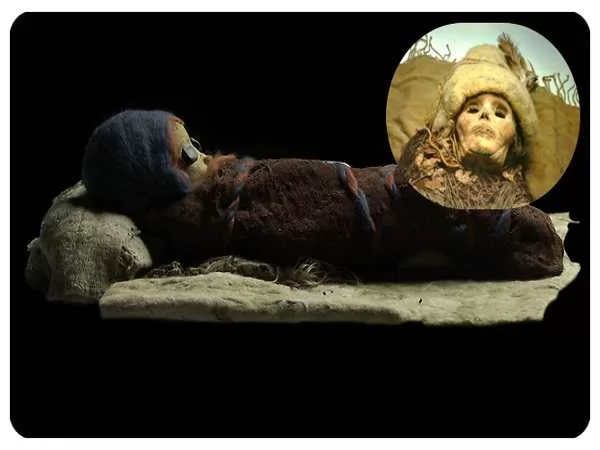In a remote desert north of Tibet, a stunning archaeological find is shedding light on an ancient civilization. Chinese archaeologists have uncovered a well-preserved cemetery dating back nearly 4,000 years in Xinjiang’s vast desert. Despite the arid conditions that typically destroy ancient remains, the dry air has preserved the bodies remarkably well.
An Unusual Discovery in the Tarim Basin
The cemetery, located near a dried-up riverbed in the Tarim Basin—a region surrounded by harsh mountain ranges and dominated by the Taklimakan Desert—has revealed a wealth of information about its enigmatic inhabitants. This ancient burial site, known as Small River Cemetery No. 5, is notable not only for its preservation but also for the distinctive European features of its occupants.
The people buried here had brown hair and long noses, suggesting a European ancestry. They were interred in upside-down boats, an unusual practice that sets them apart from other contemporary cultures. Moreover, the cemetery features a forest of phallic symbols, hinting at a profound cultural emphasis on fertility and procreation.
Unearthing the Past
The cemetery’s discovery dates back to 1934 when Swedish archaeologist Folke Bergman first found it. However, it was forgotten for decades until Chinese researchers, using GPS technology, relocated the site and began excavations between 2003 and 2005. Their findings have been summarized and translated by Victor H. Mair, a professor at the University of Pennsylvania specializing in the Tarim Basin’s prehistory.
The excavation revealed nearly 200 poles, each approximately 13 feet tall. Many of these poles were topped with flat blades, which at first resembled oars. However, closer inspection revealed these were symbolic, with poles associated with male and female genitalia, representing a deep cultural connection to fertility and procreation.
Cultural Insights and Genetic Clues

The burial site has provided valuable insights into the culture and genetics of its ancient inhabitants. Analysis of the mummies’ DNA, conducted by a team led by Hui Zhou from Jilin University, reveals a mix of European and Siberian genetic markers. This suggests that the people of the Small River Cemetery had a diverse ancestry, possibly intermarrying with populations from these regions before settling in the Tarim Basin.
The genetic study found that all the men had a Y chromosome typically found in Eastern Europe, Central Asia, and Siberia but rare in China. Meanwhile, mitochondrial DNA, which is inherited maternally, included lineages common in Europe and Siberia. This evidence supports the theory that these early settlers were of mixed ancestry, arriving in the Tarim Basin from outside China.
Symbolism and Burial Practices
The burial customs at Small River Cemetery are particularly intriguing. The deceased were placed in boats turned upside down and covered with cowhide. They wore garments such as felt caps with feathers and woolen capes with tassels. The graves also contained various artifacts, including intricately woven grass baskets and carved masks.
Notably, some of the women’s coffins included life-size wooden phalluses, and the poles above their graves were interpreted as giant phallic symbols. The men’s graves, meanwhile, featured poles with blade-like tops, symbolizing vulvas. This combination of symbols points to a society with a strong focus on fertility and procreation.
Dr. Mair and other researchers believe the symbolic poles could represent social status, reflecting the importance of status in their society. The fascination with fertility might also indicate the challenges of living in a harsh environment where infant mortality was high, making the ability to procreate and raise children a crucial aspect of life.
Connections to European Cultures
The artifacts and burial practices found at the Small River Cemetery bear striking similarities to those of ancient European cultures. Boat burials were common among the Vikings, and phallic symbols and string skirts were found in Bronze Age burials in Northern Europe. This suggests that the inhabitants of Small River Cemetery had cultural practices and symbols that were shared across a broader region than previously known.
The Language of the Ancients
While the language spoken by the cemetery’s inhabitants remains unknown, Dr. Mair proposes that it could have been Tokharian, an Indo-European language recorded in the Tarim Basin from A.D. 500 to 900. Tokharian is more closely related to European languages than to those in India and Iran. Despite being 2,000 years older than the earliest evidence for Tokharian, the continuity in cultural practices, such as the use of felt hats, suggests a link.
Exhibition and Future Research
The mummies from the Tarim Basin will soon be displayed outside Asia for the first time. An exhibition opening March 27 at the Bowers Museum in Santa Ana, California, will showcase these remarkable finds and offer insights into an ancient civilization whose influence and connections extended far beyond their desert home.

